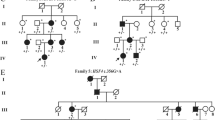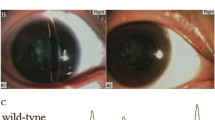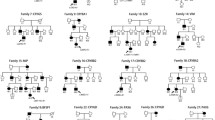Abstract
Background
To unravel the molecular genetic background responsible for autosomal dominant congenital pulverulent nuclear cataracts in a four-generation Chinese family.
Methods
Family history data were collected, ophthalmological examinations were performed, and genomic DNA was extracted from peripheral blood of the family members. The candidate genes were captured and sequenced by targeted next-generation sequencing, and the results were confirmed by Sanger sequencing. The structure modelling of the protein was displayed based on Swiss-Model Server, and its possible changes in the secondary structure were predicted using Antheprot 2000 software. The chemical dissimilarity and possible functional impact of an amino acid substitution were performed with Grantham score, PolyPhen-2, and SIFT predictions. Protein distributions were assessed by confocal microscopy.
Results
A novel heterozygous c.829C > T transition that led to the substitution of a highly conserved histidine by tyrosine at codon 277 (p.H277Y) in the coding region of connexin50 (Cx50, GJA8) was identified. Bioinformatics analysis showed that the mutation likely altered the secondary structure of the protein by replacing the helix of the COOH-terminal portion with a turn. The mutation was predicted to be moderately conservative by Grantham score and to be deleterious by both PolyPhen-2 and SIFT with consistent results. In addition, when expressed in COS1 cells, the mutation led to protein accumulation and caused changes in Cx 50 protein localization pattern.
Conclusions
This is a novel missense mutation [c.829C > T, (p.H277Y)] identified in exon 2 of Cx50. Our findings expand the spectrum of Cx50 mutations that are associated with autosomal dominant congenital pulverulent nuclear cataract.







Similar content being viewed by others
References
Wang KJ, Wang S, Cao NQ, Yan YB, Zhu SQ (2011) A novel mutation in CRYBB1 associated with congenital cataract-microcornea syndrome: the p.Ser129Arg mutation destabilizes the βB1/βA3-crystallin heteromer but not the βB1-crystallin homomer. Hum Mutat 32:E2050–E2060
Reddy MA, Francis PJ, Berry V, Bhattacharya SS, Moore AT (2004) Molecular genetic basis of inherited cataract and associated phenotypes. Surv Ophthalmol 49:300–315
Holmes JM, Leske DA, Burke JP, Hodge DO (2003) Birth prevalence of visually significant infantile cataract in a defined U.S. population. Ophthalmic Epidemiol 10:67–74
Apple DJ, Ram J, Foster A, Peng Q (2000) Elimination of cataract blindness: a global perspective entering the new millennium. Surv Ophthalmol 45(Suppl 1):S1–S196
Gao X, Cheng J, Lu C, Li X, Li F, Liu C, Zhang M, Zhu S, Ma X (2010) A novel mutation in the connexin 50 gene (GJA8) associated with autosomal dominant congenital nuclear cataract in a Chinese family. Curr Eye Res 35:597–604
Hu S, Wang B, Zhou Z, Zhou G, Wang J, Ma X, Qi Y (2010) A novel mutation in GJA8 causing congenital cataract-microcornea syndrome in a Chinese pedigree. Mol Vis 16:1585–1592
Haargaard B, Wohlfahrt J, Fledelius HC, Rosenberg T, Melbye M (2004) Incidence and cumulative risk of childhood cataract in a cohort of 2.6 million Danish children. Invest Ophthalmol Vis Sci 45:1316–1320
Wang K, Wang B, Wang J, Zhou S, Yun B, Suo P, Cheng J, Ma X, Zhu S (2009) A novel GJA8 mutation (p.I31T) causing autosomal dominant congenital cataract in a Chinese family. Mol Vis 15:2813–2820
Hejtmancik JF (2008) Congenital cataracts and their molecular genetics. Semin Cell Dev Biol 19:134–149
Arora A, Minogue PJ, Liu X, Reddy MA, Ainsworth JR, Bhattacharya SS, Webster AR, Hunt DM, Ebihara L, Moore AT, Beyer EC, Berthoud VM (2006) A novel GJA8 mutation is associated with autosomal dominant lamellar pulverulent cataract: further evidence for gap junction dysfunction in human cataract. J Med Genet 43:e2
Mackay DS, Bennett TM, Culican SM, Shiels A (2014) Exome sequencing identifies novel and recurrent mutations in GJA8 and CRYGD associated with inherited cataract. Hum Genomics 8:19
Santana A, Waiswo M (2011) The genetic and molecular basis of congenital cataract. Arq Bras Oftalmol 74:136–142
Shiels A, Bennett TM, Knopf HL, Yamada K, Yoshiura K, Niikawa N, Shim S, Hanson PI (2007) CHMP4B, a novel gene for autosomal dominant cataracts linked to chromosome 20q. Am J Hum Genet 81:596–606
Shiels A, Bennett TM, Knopf HL, Maraini G, Li A, Jiao X, Hejtmancik JF (2008) The EPHA2 gene is associated with cataracts linked to chromosome 1p. Mol Vis 14:2042–2055
Kaul H, Riazuddin SA, Shahid M, Kousar S, Butt NH, Zafar AU, Khan SN, Husnain T, Akram J, Hejtmancik JF, Riazuddin S (2010) Autosomal recessive congenital cataract linked to EPHA2 in a consanguineous Pakistani family. Mol Vis 16:511–517
Ge XL, Zhang Y, Wu Y, Lv J, Zhang W, Jin ZB, Qu J, Gu F (2014) Identification of a novel GJA8 (C×50) point mutation causes human dominant congenital cataracts. Sci Rep 4:4121
He Y, Wu J, Dressman DC, Iacobuzio-Donahue C, Markowitz SD, Velculescu VE, Diaz LA Jr, Kinzler KW, Vogelstein B, Papadopoulos N (2010) Heteroplasmic mitochondrial DNA mutations in normal and tumour cells. Nature 464:610–614
Zenteno JC, Crespí J, Buentello-Volante B, Buil JA, Bassaganyas F, Vela-Segarra JI, Diaz-Cascajosa J, Marieges MT (2014) Next generation sequencing uncovers a missense mutation in COL4A1 as the cause of familial retinal arteriolar tortuosity. Graefes Arch Clin Exp Ophthalmol 252:1789–1794
Yang Y, Wu J, Liu H, Chen X, Wang Y, Zhao M, He X (2013) Two homozygous nonsense mutations of GNPTAB gene in two Chinese families with mucolipidosis II alpha/beta using targeted next-generation sequencing. Genomics 102:169–173
Arnold K, Bordoli L, Kopp J, Schwede T (2006) The SWISS-MODEL workspace: a web-based environment for protein structure homology modelling. Bioinformatics 22:195–201
Grantham R (1974) Amino acid difference formula to help explain protein evolution. Science 185:862–864
Li WH, Wu CI, Luo CC (1984) Nonrandomness of point mutation as reflected in nucleotide substitutions in pseudogenes and its evolutionary implications. J Mol Evol 21:58–71
Maeda S, Nakagawa S, Suga M, Yamashita E, Oshima A, Fujiyoshi Y, Tsukihara T (2009) Structure of the connexin 26 gap junction channel at 3.5 a resolution. Nature 458:597–602
Xin L, Gong XQ, Bai D (2010) The role of amino terminus of mouse C×50 in determining transjunctional voltage-dependent gating and unitary conductance. Biophys J 99:2077–2086
Beyer EC, Berthoud VM (2014) Connexin hemichannels in the lens. Front Physiol 5:20
Yeager M, Harris AL (2007) Gap junction channel structure in the early 21st century: Facts and fantasies. Curr Opin Cell Biol 19:521–528
Wang N, De Bock M, Decrock E, Bol M, Gadicherla A, Vinken M, Rogiers V, Bukauskas FF, Bultynck G, Leybaert L (2013) Paracrine signaling through plasma membrane hemichannels. Biochim Biophys Acta 1828:35–50
Sellitto C, Li L, White TW (2004) Connexin50 is essential for normal postnatal lens cell proliferation. Invest Ophthalmol Vis Sci 45:3196–3202
Pal JD, Berthoud VM, Beyer EC, Mackay D, Shiels A, Ebihara L (1999) Molecular mechanism underlying a C×50-linked congenital cataract. Am J Physiol 276:C1443–C1446
Somaraju Chalasani ML, Muppirala MG, Ponnam SP, Kannabiran C, Swarup G (2012) A cataract-causing connexin 50 mutant is mislocalized to the ER due to loss of the fourth transmembrane domain and cytoplasmic domain. FEBS Open Bio 3:22–29
Minogue PJ, Tong JJ, Arora A, Russell-Eggitt I, Hunt DM, Moore AT, Ebihara L, Beyer EC, Berthoud VM (2009) A mutant connexin50 with enhanced hemichannel function leads to cell death. Invest Ophthalmol Vis Sci 50:5837–5845
Polyakov A, Shagina I, Khlebnikova O, Evgrafov O (2001) Mutation in the connexin 50 gene (GJA8) in a Russian family with zonular pulverulent cataract. Clin Genet 60:476–478
Hansen L, Mikkelsen A, Nürnberg P, Nürnberg G, Anjum I, Eiberg H, Rosenberg T (2009) Comprehensive mutational screening in a cohort of Danish families with hereditary congenital cataract. Invest Ophthalmol Vis Sci 50:3291–3303
Yan M, Xiong CL, Ye SQ, Chen YM, Ke M, Zheng F, Zhou X (2008) A novel connexin 50 (GJA8) mutation in a Chinese family with a dominant congenital pulverulent nuclear cataract. Mol Vis 14:418–424
Kumar M, Agarwal T, Khokhar S, Kumar M, Kaur P, Roy TS, Dada R (2011) Mutation screening and genotype phenotype correlation of α-crystallin, γ-crystallin and GJA8 gene in congenital cataract. Mol Vis 17:693–707
Bouvier D, Spagnol G, Chenavas S, Kieken F, Vitrac H, Brownell S, Kellezi A, Forge V, Sorgen PL (2009) Characterization of the structure and intermolecular interactions between the connexin40 and connexin43 carboxyl-terminal and cytoplasmic loop domains. J Biol Chem 284:34257–34271
Yan N, Zhao Y, Wang Y, Xie A, Huang H, Yu W, Liu X, Cai SP (2011) Molecular genetics of familial nystagmus complicated with cataract and iris anomalies. Mol Vis 17:2612–2617
Lichtenstein A, Gaietta GM, Deerinck TJ, Crum J, Sosinsky GE, Beyer EC, Berthoud VM (2009) The cytoplasmic accumulations of the cataract-associated mutant, Connexin50P88S, are long-lived and form in the endoplasmic reticulum. Exp Eye Res 88:600–609
Lichtenstein A, Minogue PJ, Beyer EC, Berthoud VM (2011) Autophagy: a pathway that contributes to connexin degradation. J Cell Sci 124:910–920
Vanita V, Singh JR, Singh D, Varon R, Sperling K (2008) A mutation in GJA8 (p.P88Q) is associated with “balloon-like” cataract with Y-sutural opacities in a family of Indian origin. Mol Vis 14:1171–1175
Beyer EC, Ebihara L, Berthoud VM (2013) Connexin mutants and cataracts. Front Pharmacol 4:43
Su D, Yang Z, Li Q, Guan L, Zhang HED, Zhang L, Zhu S, Ma X (2013) Identification and functional analysis of GJA8 mutation in a Chinese family with autosomal dominant perinuclear cataracts. PLoS One 8:e59926
Zhu Y, Yu H, Wang W, Gong X, Yao K (2014) A Novel GJA8 Mutation (p.V44A) Causing Autosomal Dominant Congenital Cataract. PLoS One 9:e115406
Rubinos C, Villone K, Mhaske PV, White TW, Srinivas M (2014) Functional effects of C × 50 mutations associated with congenital cataracts. Am J Physiol Cell Physiol 306:C212–C220
Acknowledgments
We are grateful for all the participating members of the congenital cataract family. We also express our sincere gratitude to Daoyun Zhang, Yunbing Zhang, Chencheng Wang, Zhongqiong Lu, and Qingfu Wang for their technical assistance. This work was supported by grants from the National Science and Technology Pillar Program of the Twelfth Five-year Plan (2011ZX09302-007-02) and the Research Fund for the National Nature Science Funding of China (No. 81273424 and 81170862).
Conflict of interest
All authors certify that they have NO affiliations with or involvement in any organization or entity with any financial interest, or non-financial interest in the subject matter or materials discussed in this manuscript.
Author information
Authors and Affiliations
Corresponding author
Electronic supplementary material
Below is the link to the electronic supplementary material.
ESM 1
(PDF 163 kb)
Rights and permissions
About this article
Cite this article
Chen, C., Sun, Q., Gu, M. et al. A novel Cx50 (GJA8) p.H277Y mutation associated with autosomal dominant congenital cataract identified with targeted next-generation sequencing. Graefes Arch Clin Exp Ophthalmol 253, 915–924 (2015). https://doi.org/10.1007/s00417-015-3019-x
Received:
Revised:
Accepted:
Published:
Issue Date:
DOI: https://doi.org/10.1007/s00417-015-3019-x




